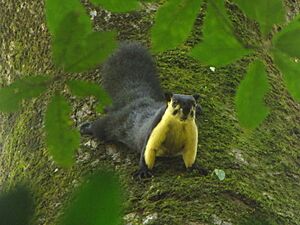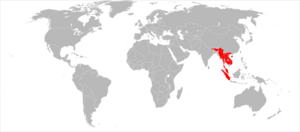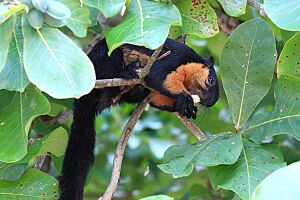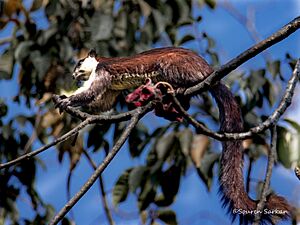Black giant squirrel facts for kids
Quick facts for kids Malayan black giant squirrel |
|
|---|---|
 |
|
 |
|
| Above in Khao Yai National Park, Thailand; below in Namdapha Tiger Reserve, India | |
| Conservation status | |
| Scientific classification | |
| Genus: |
Ratufa
|
| Species: |
bicolor
|
| Subspecies | |
|
|
 |
|
| Black giant squirrel range (erroneously missing Java and Bali) | |
| Synonyms | |
|
Tennentii, source: Layard, in Blyth, 1849 |
|
The Malayan or black giant squirrel (Ratufa bicolor) is a large tree squirrel (family Sciuridae) native to the Indomalayan zootope. It is found in tropical forests from northern Bangladesh, northeastern India, Odisha, India, eastern Nepal and Bhutan, to Myanmar and southern China (including Hainan), south through mainland Southeast Asia (Laos, Thailand, Western Malaysia, Cambodia and Vietnam), as well as several Indonesian islands and provinces (mainly Bali, Java and Sumatra).
Contents
Description

The black giant squirrel is one of the largest species of squirrel in the world. On average, a mature black giant squirrel weighs around 1.05–1.25 kg (2.3–2.8 lb) and has a snout–to–tail length of 34–37 cm (13–15 in), with the tail adding another 41–42 cm (16–17 in) long. The slightly smaller subspecies R. b. condorensis, of Vietnam's Côn Sơn Island, resembles most other giant black squirrels, yet only averages c. 30 cm (12 in) in head–to–tail length, with a tail of roughly 32 cm (13 in).
This species is, typically, distinctly bicoloured, with a very dark body, tail and backside and a paler-yellowish chin, neck and belly (countershading). The back, the top of the head, its ears and tail may vary between a deep brown to a jet-black; likewise, the underbelly may be light beige or buff-coloured in some squirrels. On the Indonesian islands of Sumatra, Java and Bali, the black giant squirrels tend to have lighter tips (i.e., "highlights") on their darker areas of fur, making them appear somewhat paler, even illuminated. On some small islands off of Myanmar, and in the Strait of Malacca, the black giant squirrels have an orange-red to yellow-red tone to their lighter sections of fur.
Habitat
Ratufa bicolor's range includes a variety of bioregions that all share the commonality of being forested. It ranges in elevation from sea level up to at least 2,500 m (8,200 ft). In recent decades, R. bicolor's habitat has been steadily encroached upon by human settlement, timber harvesting and agriculture, which along with overhunting by human predation in parts of its range, has resulted in a total loss of up to 30% of the population in the past ten years. In some places this species is protected from hunting by law or tradition.
In South Asia, R. bicolor dwells in tropical and subtropical coniferous and broadleaf forests.
In Southeast Asia, R. bicolor lives in tropical broadleaf evergreen and semi-evergreen forests, but is rarely seen in coniferous forests.
In the tropical rainforest of the Malay Peninsula and Indonesia, R. bicolor is not as abundant as elsewhere in its range, which is probably due to competition from other arboreal species (especially primates) for food in the upper forest canopy.
Among the better places to sight the black giant squirrel is the Kaziranga National Park in the state of Assam, India. Several populations are present in the lower range of the Neora Valley National Park, Kalimpong, India.
A recent study from India showed precipitation during the wettest month of a year is one of the major contributing factor for habitat preference of R. bicolor, along with land use, and vegetation. The species also may be found way beyond 1400 meters in several places. More than 20% of the presence records of the species has been observed above 1500 meters and up to 2700 meters in India. It has been predicted through study that by the year 2050, this species may loose more than 97% of its present suitable habitat due to climate change in India.
Behavior
R. bicolor is diurnal and arboreal, but sometimes climbs down from the forest canopy to feed on the ground. The black giant squirrel rarely enters plantations or settlements, preferring the wild forest.
Its diet consists of seeds, pine cones, fruits, and leaves. It is primarily solitary, and has a litter of from 1 to 2 young, which it raises in a drey (or nest), often located within a hollow space of a tree.
Taxonomy
Further study is required to determine whether Ratufa bicolor actually represents several similar species.
The table below lists the ten recognized subspecies of Ratufa bicolor, along with any synonyms associated with each subspecies:
| Subspecies | Authority | Synonyms |
|---|---|---|
| R. b. bicolor | Sparrman (1778) | albiceps, baliensis, humeralis, javensis, leschnaultii, major, sondaica |
| R. b. condorensis | Kloss (1920) | none |
| R. b. felli | Thomas and Wroughton (1916) | none |
| R. b. gigantea | McClelland (1839) | lutrina, macruroides |
| R. b. hainana | J. A. Allen (1906) | stigmosa |
| R. b. leucogenys | Kloss (1916) | sinus |
| R. b. melanopepla | Miller (1900) | anambae, angusticeps, dicolorata, fretensis, penangensis, peninsulae, tiomanensis |
| R. b. palliata | Miller (1902) | batuana, laenata |
| R. b. phaeopepla | Miller (1913) | celaenopepla, marana |
| R. b. smithi | Robinson and Kloss (1922) | none |
Gallery



